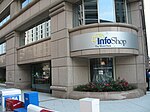International Bank for Reconstruction and Development
The International Bank for Reconstruction and Development (IBRD) is an international financial institution, established in 1944 and headquartered in Washington, D.C., United States, that is the lending arm of World Bank Group. The IBRD offers loans to middle-income developing countries. The IBRD is the first of five member institutions that compose the World Bank Group. The initial mission of the IBRD in 1944, was to finance the reconstruction of European nations devastated by World War II. The IBRD and its concessional lending arm, the International Development Association (IDA), are collectively known as the World Bank as they share the same leadership and staff.Following the reconstruction of Europe, the Bank's mandate expanded to advancing worldwide economic development and eradicating poverty. The IBRD provides commercial-grade or concessional financing to sovereign states to fund projects that seek to improve transportation and infrastructure, education, domestic policy, environmental consciousness, energy investments, healthcare, access to food and potable water, and access to improved sanitation. The IBRD is owned and governed by its 189 member states, with each country represented on the Board of Governors. The IBRD has its executive leadership and staff which conduct its normal business operations. The Bank's member governments are shareholders which contribute and have the right to vote on its matters. In addition to contributions from its member nations, the IBRD acquires most of its capital by borrowing on international capital markets through bond issues at a preferred rate because of its AAA credit rating. In 2011, it raised US$29 billion in capital from bond issues made in 26 different currencies. The Bank offers several financial services and products, including flexible loans, grants, risk guarantees, financial derivatives, and catastrophic risk financing. It reported lending commitments of $26.7 billion made to 132 projects in 2011.
Excerpt from the Wikipedia article International Bank for Reconstruction and Development (License: CC BY-SA 3.0, Authors).International Bank for Reconstruction and Development
H Street Northwest, Washington
Geographical coordinates (GPS) Address Website Nearby Places Show on map
Geographical coordinates (GPS)
| Latitude | Longitude |
|---|---|
| N 38.899 ° | E -77.0425 ° |
Address
World Bank (MC Building)
H Street Northwest 1818
20037 Washington
District of Columbia, United States
Open on Google Maps








